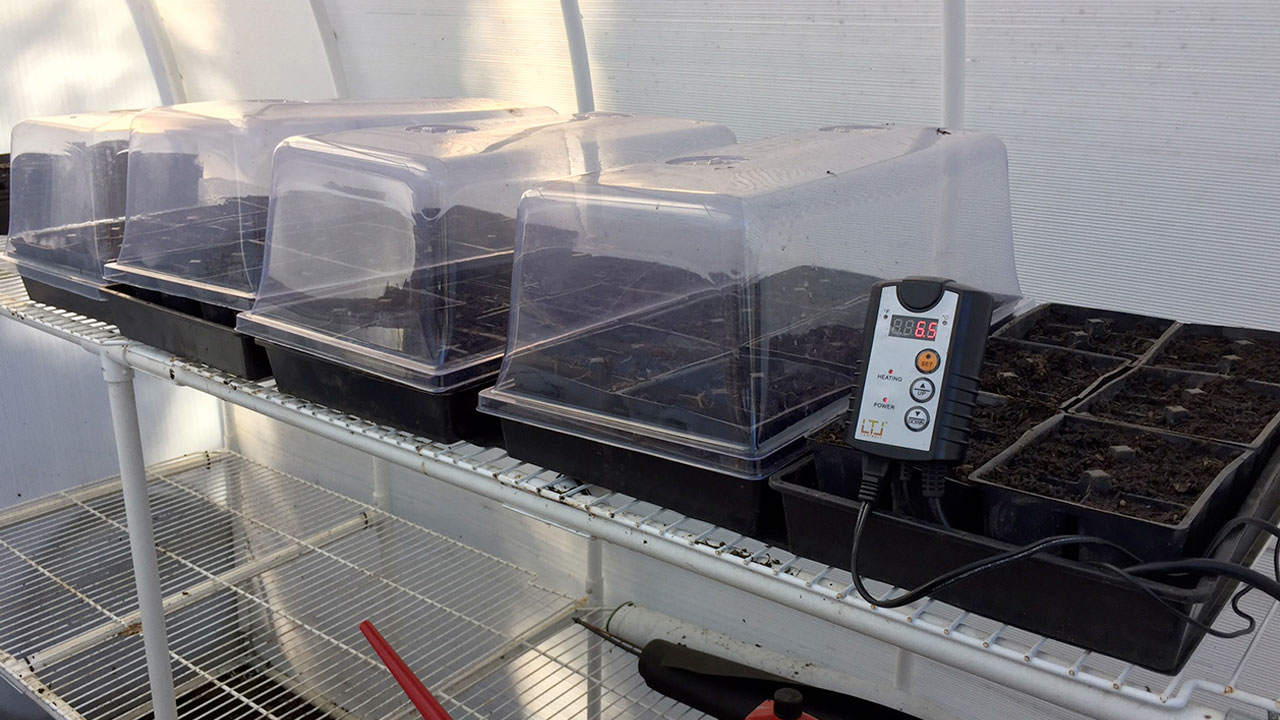Starting your Veggies from Seed
Feb 24th 2016
Starting a vegetable garden from seed is an age old tradition. At Dripworks I am once again getting the display garden ready for planting. With Spring less than a month away, I have the “itch” to roll out the electric heating mat on an upper shelf in our little Solexx greenhouse and plug it in. The mat has a thermostat that controls the temperature to give the seeds in the seed tray a nice constant 68-72 degrees. These seeds will then have a good chance to germinate quickly. Our trays have clear plastic lids to keep the moisture and heat in and can be bought at most nurseries. Using last year’s plastic six-pack seedling container, waxed paper cup, or small yogurt container works well too for seed starting.
At home, putting the seed starting tray on a table or window sill in front of a south facing window or under a “grow light” would work well as long as you rotate the tray every few days. The seed tray should come with a “drip tray” underneath that will collect water as it drains through. You can use a spray bottle or an empty and clean dish soap bottle to add a tiny bit of water when dry. Use your finger to feel the soil for moistness. Try not to overwater. This might cause root rot and drive the oxygen out of the soil.
Fill the tray with a seed starting soil mix or other sterilized bagged soil. Soak the soil with water and then squeeze out the excess water before adding it to the tray or container. Compress the soil into each square of the tray of each container before adding the seed. I find that pushing a pencil point into the soil a quarter of an inch makes a “perfect” depression in which to plant the seeds. Cover the seeds and pat down.
In the first two weeks it is important to check the seed tray daily. If the seeds have poked through the soil and are under the clear plastic cover, additional water isn’t necessary right away. If more than one seed sprouts, snip out the runts with a scissor so as not to disturb the one you are leaving.
You’re better off planting certain types of vegetables by seed directly in your garden. Peas and beans are quite cold hardy and do best directly sowed. Squash is fairly hardy and can be planted when the danger of frost is past. Use a row cover such as Agribon for protection from the cold. Corn and melons thrive if planted as the temperature starts to climb in the middle of May and the days get longer.

Your local garden center or favorite online gardening site should have a wide variety of seed. I’m a little particular about what I want to grow. I want my food to be as healthy as possible. To start with, I use organic soil and compost in my beds and also choose heirloom (non GMO) seed from Baker Creek Seed or Sustainable Seed Company. Genovese basil (for pesto), a variety of tomatoes and lettuces, hot habanero or serrano peppers, red bell peppers, Delicata squash, rainbow chard, and dinosaur kale are must haves for me. Carrots (Nantes or Chantaney), beets for roasting and salads, radishes, red onions for sandwiches, and a small bed of potatoes will fill in any space in your garden that may be available. Another favorite, Garlic must be planted in the Fall for a June harvest.
My mom was always in the garden. Although it didn’t look as much fun as playing catch with dad or shooting baskets with my brother, I saw what she was doing. Seeing her beautiful flower arrangements and tasting the some of her home grown vegetable dishes evidently got me hooked on eating some greens and gardening. If your kids don’t care to eat vegetables, getting them to help with seed starting might coerce them to get on board.


